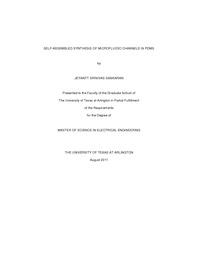
ATTENTION: The works hosted here are being migrated to a new repository that will consolidate resources, improve discoverability, and better show UTA's research impact on the global community. We will update authors as the migration progresses. Please see MavMatrix for more information.
Show simple item record
| dc.contributor.author | Sankaran, Jeyantt Srinivas | en_US |
| dc.date.accessioned | 2011-10-11T20:49:29Z | |
| dc.date.available | 2011-10-11T20:49:29Z | |
| dc.date.issued | 2011-10-11 | |
| dc.date.submitted | January 2011 | en_US |
| dc.identifier.other | DISS-11265 | en_US |
| dc.identifier.uri | http://hdl.handle.net/10106/6217 | |
| dc.description.abstract | The field of microfluidics is expanding rapidly finding applications in diverse areas ranging from solid state devices and semiconductors to bio- applications in cell culture and DNA assays and micro- arrays. PDMS has been a commonly used material for the fabrication of microfluidic devices. Apart from traditional lithographic techniques, soft lithography has also been prevalent in fabrication of micro channels in polymers like PDMS. We propose a novel technique for fabrication of micro/nanochannels in PDMS using hydrophilic- hydrophobic interactions. Several hydrophilic materials have been tried for the fabrication of such channels. This research revolves around the science behind the phenomenon, the interactions at the interface between hydrophobic matrix and the hydrophilic material, the thermodynamics involved and the behavior of the micro/ nano particles inside a polymer matrix. Iron- oxide nanoparticles and polyurethane beads have been employed before for the fabrication of such devices. We have now introduced Poly ethylene oxide (PEO) as the hydrophilic material in the fabrication of micro/nano channels in PDMS using hydrophobic-hydrophilic interactions. The introduction of PEO for this novel technique of micro/nano channel fabrication provides ease of handling, better inherent alignment and excellent repeatability. One of the remarkably consistent results of the experiment was the tapered structure of the channels obtained. These channels were closed from both the top and the bottom. Thin layers of PDMS membranes were sliced in order to create `through' channels. It was observed that the slicing of the PDMS provided us with channels whose dimensions can be approximated to be cylindrical. These cylindrical `through' channels have been shown to act as membranes and preliminary studies indicate that these can be used as micro- reactors for protein purification experiments. | en_US |
| dc.description.sponsorship | Iqbal, Samir M. | en_US |
| dc.language.iso | en | en_US |
| dc.publisher | Electrical Engineering | en_US |
| dc.title | Self-assembled Synthesis Of Microfluidic Channels In PDMS | en_US |
| dc.type | M.S. | en_US |
| dc.contributor.committeeChair | Iqbal, Samir M. | en_US |
| dc.degree.department | Electrical Engineering | en_US |
| dc.degree.discipline | Electrical Engineering | en_US |
| dc.degree.grantor | University of Texas at Arlington | en_US |
| dc.degree.level | masters | en_US |
| dc.degree.name | M.S. | en_US |
Files in this item
- Name:
- Sankaran_uta_2502M_11265.pdf
- Size:
- 1.733Mb
- Format:
- PDF
This item appears in the following Collection(s)
Show simple item record


